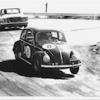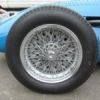Straight eight crankshafts
#1

Posted 24 December 2009 - 21:07
I am trying to understand the various straight eight crankshafts used in the 20's and 30's. It appears that early engines, Bugatti, Duesenberg, FIAT, Miller, used a "4-4" crank, essentially two four cylinder cranks offset by 90 degrees and that the later straight eights, Alfa and Mercedes, used a "2-4-2" crank which had two opposed cranks at each end and a four cylinder crank in the middle. I understand the "2-4-2" is better balanced. Who came up with this idea and what was the first "2-4-2" crank straight eight ? Merry Christmas.
Paul
Advertisement
#2

Posted 24 December 2009 - 23:20

(Austin Harris)
Edited by Allan Lupton, 08 May 2015 - 16:45.
#3

Posted 24 December 2009 - 23:54
Counterbalancing? What's that?
#4

Posted 25 December 2009 - 00:04
With about the torsional rigidity of an Austin 7 crank. eg a bent paper clip!Some of the earlier arrangements were even simpler: here's D.M. Weigel with the crankshaft of his engine
(Austin Harris)
#5

Posted 08 May 2015 - 13:00
If someone can make the photo of Mr Weigel holding his eight cylinder crankshaft,( which is taller than he is) re-appear, It would be good if someone who is a better engineer than I could look hard at it. I found today a print that I made at the time it was posted. It is not a straight eight at all. It is actually a flat-plane V8 crankshaft, similar in concept to those of Cadillac from 1914 till about 1922. It is also like the model L Lincoln. However, Henry Leland's engineers were a bit smarter than when they designed the flat-plane Cadillacs, because, like the V8 version of the Liberty, the cylinder banks were at 60 degrees instead of 90 degrees; and the uneven firing avoided some of the vibration periods. It looks to me as though the bore may have exceeded the stroke like many cars in the Kaiserpries formula of 1907, such as the 8 litre Isotta with which Minioa won the 07 Coppa Florio, and identical cars raced successfully at Savannah in 1908. This engine may have been severely limited in rpm; and in fact it may have been like a railway cup of tea, . . . big and weak.
#6

Posted 08 May 2015 - 15:28
I wonder if it's on another thread?
It certainly did have long journals on it.
When did Cadillac go back to ninety degrees, Ivan? About 1924?
#7

Posted 08 May 2015 - 16:55
I've replaced the photo in the original post (no 2).
I had used a reduced size version from Austin's site but it wasn't a permanent image so got lost.
The Weigel motor was effectively two of his 40 h.p. motors and they were 130 × 140 mm bore and stroke, a lot nearer "square" then many contemporary designs.
It seems to be a single plane crankshaft so would fire cylinders in pairs. I still feel the diameter at the rear main bearing is not designed with much torque in mind!
#8

Posted 08 May 2015 - 23:52
Although it's a 'straight 6' crankshaft, this one out of my 1924 Minerva may be of interest. Quite an advanced design for the day.
After years of service [the car has been road-registered, and used for 90 years] the crank is still as good as new, despite a big-end bearing failure. We re-built the [sleeve valve] engine recently, and it is running beatifully again...ready for another 90 years.
#9

Posted 22 May 2015 - 12:36
According to Hendry, Cadillac Chief engineer told him they had the first split-plane crankshaft running in a model 61 Cadillac during 1921. When Ernest Seaholm was absent in Europe, Charles Kettering and GM mathematician Hutchinson persuaded management to change; and when he returned they were manufacturing V63 model with the new crankshaft during 1923. This was an important improvement because demand had grown rapidly for closed body types. Apparently these bodies sort of resonated with the vibration periods of the flat plane crank engines. The first engine most probably had 1 7/8" crankpins in 1921, while the production engines from sometime 1923 had 2 3/8" diameter crankpins. There would have been a lot of extra effort to make a special set of fork-and-blade conrods for an experimental engine. It is said that Wright at Dayton, Ohio, had a V8 Hispano aero engine running a split plane crank at about the same time.
Ray, I saw a trace of a message from someone who you may have referred to me to find out more about Locomobile Junior Eight cars. I cannot find where it has disappeared. If you can help direct him again, I can tell him quite a lot. These, and the Marmon 78 were both the responsibility of Barney Roos, and were very similar in some ways.
#10

Posted 22 May 2015 - 13:32
I don't know how I found it and I don't know if I could find it again, but it was a very old question he'd asked.
#11

Posted 22 May 2015 - 15:54
Gentlemen I present A CRANK ! not a straight eight, but impressive none the less. also brought to mind is a photo I've seen some where of Jenks with the crank from one of his motors. click the photo to view, and the little boxes at left let you make it larger. ![]()
https://revslib.stan...log/hg527cc8383
group7 in Canada
#12

Posted 22 May 2015 - 23:03
Although it's a 'straight 6' crankshaft, this one out of my 1924 Minerva may be of interest. Quite an advanced design for the day.
After years of service [the car has been road-registered, and used for 90 years] the crank is still as good as new, despite a big-end bearing failure. We re-built the [sleeve valve] engine recently, and it is running beatifully again...ready for another 90 years.
That is almost certainly a billet crank. The manufacture a hundred years or so again says that they had some very good machines even then.
And yes very modern
#13

Posted 22 May 2015 - 23:11
Gentlemen I present A CRANK ! not a straight eight, but impressive none the less. also brought to mind is a photo I've seen some where of Jenks with the crank from one of his motors. click the photo to view, and the little boxes at left let you make it larger.
https://revslib.stan...log/hg527cc8383
group7 in Canada
There is a pic somewhere on this site of an even bigger one. For a ship.
At the Peterborough South Oz train museum a decade ago they were giving a ex Ghan railway engine an engine overhaul. Crank nearly that big. straight six, All familiar to me except that the bores were nearly a foot and the stroke was probably more. Big sideplates on the engine to get at the conrod bolts.
There is two or 3 more of those engines seemingly abandoned at Marree SA railyards. Sad really. And they are so big you would really struggle to get one out now that the railline is long gone.
#14

Posted 24 May 2015 - 13:48
Hello,
I am trying to understand the various straight eight crankshafts used in the 20's and 30's. It appears that early engines, Bugatti, Duesenberg, FIAT, Miller, used a "4-4" crank, essentially two four cylinder cranks offset by 90 degrees and that the later straight eights, Alfa and Mercedes, used a "2-4-2" crank which had two opposed cranks at each end and a four cylinder crank in the middle. I understand the "2-4-2" is better balanced. Who came up with this idea and what was the first "2-4-2" crank straight eight ? Merry Christmas.
Paul
The Packard Single Eight introduced in the summer of 1923 was the first. History and technical description here.
http://www.macsmotor...d-single-eight/
#15

Posted 09 October 2019 - 11:57
Article mentioning the Weigel crankshaft (The Automobile/March 1907):
Original image:
http://austinharris....-crankshaft/508
#16

Posted 09 October 2019 - 12:13
Not an inline engine as mentioned in the text.
#17

Posted 09 October 2019 - 22:19
I have to agree with Ivan that this crank could only have been a flat-plane crank for a Vee engine...
Not an inline engine as mentioned in the text.
As the article says, D.M. Weigel built a straight-eight and that is its crankshaft.
As I wrote in post 7 it was effectively two straight-fours on a common crankshaft and seems to have had its cylinders working in pairs - really pairs of pairs as nos 1 and 2 were in step with nos 7 and 8 and 3,4,5 & 6 were in step, so pairs of cylinders would fire together.
I can't find a photo of the engine, but here's the car.

#18

Posted 10 October 2019 - 00:53
As the article says, D.M. Weigel built a straight-eight and that is its crankshaft.
As I wrote in post 7 it was effectively two straight-fours on a common crankshaft and seems to have had its cylinders working in pairs - really pairs of pairs as nos 1 and 2 were in step with nos 7 and 8 and 3,4,5 & 6 were in step, so pairs of cylinders would fire together.
I can't find a photo of the engine, but here's the car.
The width of the engine, even though it isn't visible, certainly suggests a straight 8. Which also confirms what the article says.
The wheelbase of the car is surely twice the engine length. What a contrast with the Christie car that is also mentioned.
#19

Posted 10 October 2019 - 07:00
And I always thought that Colin Chapman was the originator of the reclining driver seat to reduce frontal area, in the early 60s.
Advertisement
#20

Posted 10 October 2019 - 07:45
And I always thought that Colin Chapman was the originator of the reclining driver seat to reduce frontal area, in the early 60s.
Joking aside, Chapman was always prepared to use other people's ideas if he thought his designs would benefit. ![]()
#21

Posted 10 October 2019 - 10:05
Joking aside, Chapman was always prepared to use other people's ideas if he thought his designs would benefit.
That was sometimes true, but for me his real talent was examining other peoples' ideas, seeing the flaws in their execution or thinking, and coming up with something better. Not unreasonably, Colin would often then claim the idea as his own, In my time at Lotus, I saw and experienced all that at first hand. The Great Man never believed in patents though. He saw it as just telling everyone else what you were doing, often not a good idea.
#22

Posted 10 October 2019 - 10:28
Description of the Weigel (The Automobile, June 1907):

= = = =
and btw the straight-eight Porthos, 1907 GP de l'ACF (La Vie Automobile, June 1907)
#23

Posted 10 October 2019 - 11:16
It is actually a flat-plane V8 crankshaft, similar in concept to those of Cadillac from 1914 till about 1922. It is also like the model L Lincoln. However, Henry Leland's engineers were a bit smarter than when they designed the flat-plane Cadillacs, because, like the V8 version of the Liberty, the cylinder banks were at 60 degrees instead of 90 degrees; and the uneven firing avoided some of the vibration periods.
Interesting that the 60 deg V-angle of the Lincoln V8 is attributed to the avoidance of vibration periods. I imagine this refers to torsional vibration, as so lucidly explained by PM Heldt in the 25 July 1931 issue of Automotive Industries, because the unbalanced forces and moments (reciprocating) would probably be worse with this angle instead of the usual 90 deg. (All this assumes the use of the flat-plane 4-throw crankshaft, not the possible, complicated alternatives of 8 throws or split crankpins)
Could it be that this angle was chosen also so as to fit within the usual narrow hood (bonnet?) of that era? And thus avoid a radical appearance that might put off conservative buyers?
I seem to have read that the original Cadillac V16 used the 45 deg angle, in preference to the alternative 135 deg, for just this reason, even though it forced the use of ohv which was unusual at the time (1930?). While the later Cadillac V16 (1934) used 135 deg and side valves, to fit into the lower and wider hood that was fashionable by then!
#24

Posted 11 October 2019 - 00:34
Description of the Weigel (The Automobile, June 1907):
= = = =
and btw the straight-eight Porthos, 1907 GP de l'ACF (La Vie Automobile, June 1907)
Thank you, RD, for the definitive answers to the questions.
#25

Posted 11 October 2019 - 00:43
Rather like four Triumph twins coupled in a line as each pair of pistons travelled a parallel course.
#26

Posted 15 October 2019 - 21:01
Hi Guys,
I deal with the whole straight-eight evolution in the new "Ballot" books from Dalton Watson. I don't have my references with me but if I recall correctly a straight-eight Mercedes aero engine in WW1 was the first to have a 2-4-2 crankshaft.
It's a great story!
#27

Posted 05 January 2020 - 17:28
Another early straight-eight, built in 1904 - the Swiss Dufaux.
Three photos dated 3 October 1904 - flying kilometre (kilomètre lancé) between Dourdan and St. Arnoult - Frédéric Dufaux and his straight-eight Dufaux.
Dufaux covered the flying kilometre in 30 2/5 seconds and the standing mile in 63 2/5.
(fastest times of the day made by Paul Baras in a Darracq in 25 1/5 and 52 1/5)
(photos from the Jules Beau collection, Bibliothèque Nationale/Paris)


Earlier in the season, in September 1904, between Geneva and Chancy, Dufaux covered a flying kilometer in 31 1/5 seconds.
In June 1904, Dufaux and his Dufaux were unable to start in the Bennett Cup through the Taunus mountains after a steering arm broke the day before the race, just as the car was proceeding to the weight control. There were rumors that the Dufaux was the victim of foul play and that the steering arm had been filed through.
#28

Posted 05 January 2020 - 20:29
Roger Lund
#29

Posted 17 January 2020 - 17:17
Early American straight-eight:
In September 1905, Walter Winchester, mechanic Mathew Raus and this air-cooled straight-eight Franklin (built at Syracuse, New York) started in the Vanderbilt elimination on Long Island. Bore-and-stroke = 5.0 x 5.0 inches = 785 cubic inches/12,8 litres, OHV-head. (photos Detroit Public Library):

#30

Posted 27 January 2020 - 09:44
The Maxwell-Briscoe Motor Co. of Tarrytown, New York, assembled a straight-eight for the 1906 Vanderbilt Cup elimination. The car was damaged during practice and did not start. The straight-eight was composed of two four-cylinders of the model M stock car in a row. Bore-and-stroke dimensions were 5.0 x 5.0 inches, 785 cubic inches. (photos The Motor Way and Detroit Public Library)
The crank- and camshaft of the straight-eight in the Maxwell-Briscoe shop.
btw:
A flat-twelve with opposed, slightly staggered cylinders (a few decades before the 512, 1512, 312 or 917) could not be prepared in time for the 1906 Vanderbilt. The twelve had the dimensions of 6 1⁄4 x 6.0 inches, 2,207 cubic inches (36 litres). There was no flywheel. Two radiators were mounted lengthwise above each cylinder row. Power was transmitted by a two-speed gearbox.
#31

Posted 27 January 2020 - 12:16
Early American straight-eight:
In September 1905, Walter Winchester, mechanic Mathew Raus and this air-cooled straight-eight Franklin (built at Syracuse, New York) started in the Vanderbilt elimination on Long Island. Bore-and-stroke = 5.0 x 5.0 inches = 785 cubic inches/12,8 litres, OHV-head. (photos Detroit Public Library):
The car and the engine look so naked. Seemingly an up draught carb well back on the right side. Hardly ideal for distribution. But where is the exhausts?
And ofcourse being aircooled no radiator
#32

Posted 27 January 2020 - 16:39
Exhaust side of a straight-six Franklin dated 1906 - same layout. The overhead exhaust was assisted by an additional exhaust at bottom-dead-centre level.
(photo Detroit Public Library)
#33

Posted 28 January 2020 - 09:10
Yeah, but there's no exhaust visible in the picture of the car on the weighbridge. I guess the car made a bit of a racket... ![]()
#34

Posted 29 January 2020 - 10:49
#35

Posted 01 February 2020 - 10:07
The straight-eight Franklin was heavy, despite the light appearance. At the official weighing of the 1905 Vanderbilt elimination it was 22 pounds below the maximum of 2,204 pounds (1,000 kilograms). Possible that part of the exhaust system had been removed.
Description of the Franklin cylinder - published in January 1906:

#36

Posted 01 February 2020 - 16:30
Early American straight-eight:
In September 1905, Walter Winchester, mechanic Mathew Raus and this air-cooled straight-eight Franklin (built at Syracuse, New York) started in the Vanderbilt elimination on Long Island. Bore-and-stroke = 5.0 x 5.0 inches = 785 cubic inches/12,8 litres, OHV-head. (photos Detroit Public Library):
Just a quick note of appreciation to Robert Dick for the information and pictures in this thread. I now feel inadequate when viewing the 1.4 litre 4 cylinder in my road car, and can't even match the mechanic's hat.
Edited by Sterzo, 01 February 2020 - 16:30.





















